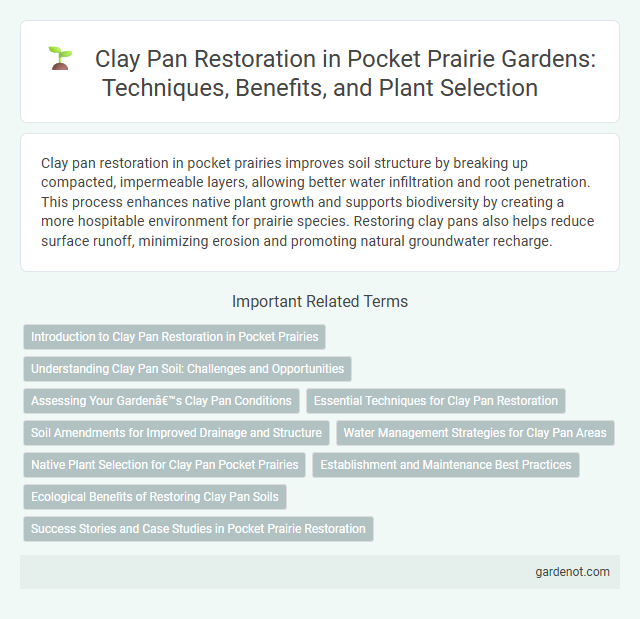Clay pan restoration in pocket prairies improves soil structure by breaking up compacted, impermeable layers, allowing better water infiltration and root penetration. This process enhances native plant growth and supports biodiversity by creating a more hospitable environment for prairie species. Restoring clay pans also helps reduce surface runoff, minimizing erosion and promoting natural groundwater recharge.
Introduction to Clay Pan Restoration in Pocket Prairies
Clay pan restoration in pocket prairies revitalizes compacted, dense clay layers that hinder water infiltration and root growth. Techniques such as deep tilling, organic matter incorporation, and planting deep-rooted prairie species enhance soil structure and promote biodiversity. Restoring clay pans improves hydrology, supports native plant communities, and increases resilience to drought in pocket prairie ecosystems.
Understanding Clay Pan Soil: Challenges and Opportunities
Clay pan soils are characterized by a dense, compacted layer that restricts water infiltration and root penetration, posing challenges for pocket prairie restoration. Understanding the unique water retention properties and nutrient limitations of clay pan soil allows for targeted amendment strategies, such as incorporating organic matter and selecting deep-rooted native plants to improve soil structure. These practices enhance biodiversity and ecosystem resilience, turning clay pan constraints into restoration opportunities.
Assessing Your Garden’s Clay Pan Conditions
Assessing your garden's clay pan conditions involves evaluating soil texture, drainage capacity, and compaction levels to determine the extent of water retention and root growth limitations. Use a soil probe or shovel to sample and visually inspect the dense, impermeable clay layer beneath the topsoil that restricts aeration and moisture movement. Identifying these characteristics is essential for planning effective amendments like organic matter incorporation and aeration techniques to restore pocket prairie health and biodiversity.
Essential Techniques for Clay Pan Restoration
Clay pan restoration involves breaking up the compacted, impermeable layer to improve water infiltration and root penetration. Essential techniques include deep ripping or subsoiling to fracture the hardpan, adding organic matter to enhance soil structure, and planting deep-rooted vegetation to maintain soil porosity. These methods collectively restore soil health, increase moisture retention, and promote biodiversity in pocket prairie ecosystems.
Soil Amendments for Improved Drainage and Structure
Soil amendments like gypsum and organic compost enhance clay pan restoration by breaking up compacted layers to improve drainage and soil structure. Incorporating biochar increases porosity and microbial activity, accelerating soil recovery and water infiltration rates. Proper amendment application restores aeration, reduces surface crusting, and supports sustainable plant growth in pocket prairies.
Water Management Strategies for Clay Pan Areas
Clay pan restoration in pocket prairies relies heavily on effective water management strategies that enhance infiltration and reduce surface runoff. Techniques such as creating micro-topographic variations, installing infiltration trenches, and applying organic amendments help to break the hardpan layer, promoting water retention and supporting native vegetation growth. Implementing these strategies improves soil moisture availability, reduces erosion, and restores natural hydrological functions within clay pan areas.
Native Plant Selection for Clay Pan Pocket Prairies
Selecting native plants for clay pan pocket prairie restoration is critical due to the unique hydrology and soil composition of clay pans, which are characterized by dense, compacted clay soil with poor drainage. Native species such as purple coneflower (Echinacea purpurea), switchgrass (Panicum virgatum), and butterfly milkweed (Asclepias tuberosa) exhibit strong tolerance to periodic waterlogging and drought, making them ideal for these challenging environments. Incorporating deep-rooted native grasses and forbs enhances soil structure, promotes infiltration, and supports diverse pollinator populations within restored clay pan ecosystems.
Establishment and Maintenance Best Practices
Clay pan restoration in pocket prairies requires precise establishment techniques such as scarifying compacted soil and incorporating organic matter to enhance infiltration and root penetration. Maintenance best practices involve periodic monitoring of soil moisture levels and controlling invasive species through targeted mowing or selective herbicide application to sustain native plant vigor. Consistent mulching around young plants helps retain soil moisture and reduce erosion, promoting long-term soil structure stability.
Ecological Benefits of Restoring Clay Pan Soils
Restoring clay pan soils significantly improves water infiltration and retention, reducing surface runoff and erosion while enhancing groundwater recharge. This leads to increased soil fertility and biodiversity, supporting native plant growth and creating habitats for diverse wildlife. Improved soil structure and nutrient cycling contribute to healthier ecosystems and greater resilience against droughts and flooding.
Success Stories and Case Studies in Pocket Prairie Restoration
Clay pan restoration in pocket prairies has demonstrated significant success in improving soil drainage and enhancing native plant growth. Case studies from the Midwest reveal that breaking up compacted clay layers with deep tilling and adding organic amendments increases water infiltration and supports biodiversity. These restoration efforts result in healthier prairie ecosystems, promoting pollinator habitats and sustainable land use.
Clay pan restoration Infographic

 gardenot.com
gardenot.com